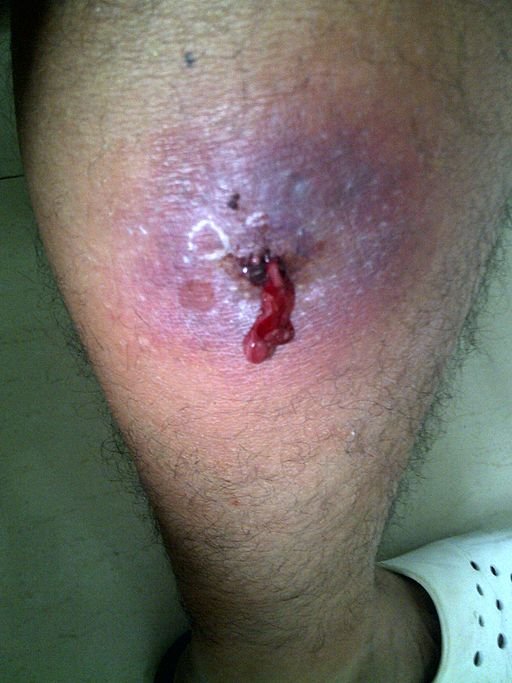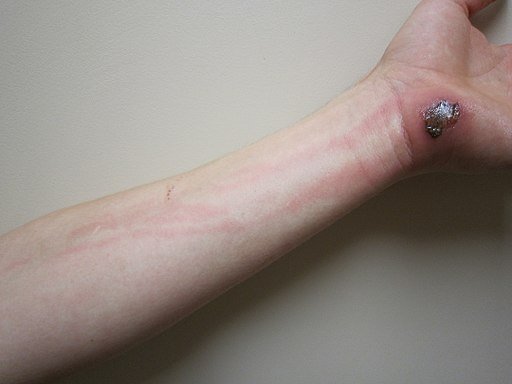Introduction
Hello everyone, hope you are having a beautiful Sunday, because it's been a very wonderful day over here. I feel so happy talking to you all again. Today, I would be telling us about a very dangerous bacterial infection called Cellulitis. This infection affects deeper tissues of the skin, that is, the dermis and the subcutaneous tissues. Cellulitis is mainly caused by streptococcus and staphylococcus bacteria. It affects people of all races and ages. The symptoms of this bacterial infection may include, redness of skin, feeling of warmth in infected area, fever etc.
There are different types of Cellulitis based on where they occur, these include, Perianal streptococcal (anus), Orbital cellulitis (eye), Necrotizing fasciitis (dermis), breast cellulitis (breast). People with greater risk for cellulitis are those with blood circulation problems, diabetes, weakened immune system, lymphedema etc. Sadly, Cellulitis caused by Hemophilus influenza affects children under 6 years of age. It is seen on their face, arms, and upper torso. This bacterial infection can be easily diagnosed by doctors. It can be treated using antibiotics, only in rare cases, when symptoms worsen that the infected person may need to be hospitalized.
Please note, if this bacterial infection is not properly treated, it may lead to complications such as blood infection, bone infection, inflammation of lymph vessels, and tissue death. Cellulitis can be prevented by ensuring that you clean breaks and cracks in your skin immediately and apply antibiotics ointment regularly. Also, wounds should be properly covered with a bandage and it should be changed on a daily basis, until scab forms. If antibiotic treatment are used, symptoms should disappear in three to ten days after beginning.
.jpg)
Wikimedia commons: Cellulitis after surgery
What is Cellulitis?
Like I mentioned above, Cellulitis is a bacterial infection of the skin. It involves the deeper tissues of the skin, that is, the dermis and subcutaneous tissue. It is caused by bacteria, the main bacteria that causes Cellulitis are streptococcus and staphylococcus. They are circular in shape. They are known to cause other diseases such as sore throat, Pneumonia and boil infections etc.
Some other bacteria can also cause cellulitis such as Hemophilius influenza, Pneumococcus and Clostridium species. It has been found that cellulitis affects people of all races and ages, young and old. Although it affects people of all ages, it is common in middle-aged and elderly people. Cellulitis is a non- communicable disease, that is, it cannot be transmitted from one person to another by ordinary contact. This is because cellulitis affects tissues at the deeper layer of the skin, and the infection is covered by the epidermis, which is the upper layer of the skin.
What are the signs and symptoms of cellulitis?
Cellulitis is always very easy to notice. The signs and symptoms of this bacterial infection includes- redness or inflammation of the skin, a feeling of warmth in the infected area, a fever, pain in the affected area, rash or skin sore that appears and spread very quickly, pus formation around the central area of the infection.
In cases of severe cellulitis, infection may include these signs and symptoms- sweating, fatigue, muscle aches, feeling of illness, warm skin. There are some symptoms that signal that the cellulitis infection is spreading to other areas. These symptoms include- blistering, drowsiness, red streaks, lethargy. The doctor should be immediately contacted if any of these symptoms is experienced.
Where does cellulitis occur?
According to the places where cellulitis occur or appear on the body, it can be classified into different types namely- Perianal streptococcal cellulitis, Orbital cellulitis, Necrotizing fasciitis, breast cellulitis.
Perianal streptococcal cellulitis:
Perianal streptococcal cellulitis is caused by streptococcus bacteria, it leads to the swelling of anus and rectum. It occurs mainly in children and it is observed to occur with pharyngitis or impetigo and strep throat. The infection starts from the mouth and nose, and it is spread to the anus via hands. This occurs when the child wants to clean him/herself after using the bathroom.
Orbital cellulitis:
Orbital cellulitis is known to gain access into the eye via direct sinus infection or trauma. Just like the perianal streptococcal cellulitis mentioned above, orbital cellulitis is also mostly common in children. Here are some symptoms of orbital cellulitis- swelling, fever, poor vision, discoloration of the eyelids, feeling of difficulty moving the eye. Orbital cellulitis is among the most dangerous cellulitis infections, because if it is not treated immediately and very quickly, it may result to blindness or vision loss. Cellulitis at this level often require hospital stay, and the treatment with antibiotics and in some cases surgery.
Necrotizing fasciitis:
Necrotizing fasciitis is hardly seen in healthy individuals, this bacteria occurs when cellulitis spreads to the dermis, that is , the deeper layers of soft tissues. Some symptoms of Necrotizing fasciitis may include- redness of infected area, blisters, high fever, inflammation, severe pain. It is often times referred to as flesh-eating bacteria. Necrotizing fasciitis can actually spread quickly and may lead to death. This is also a very dangerous type of cellulitis, just like the orbital cellulitis, it often require treatment in the hospital which would involve the use of intravenous antibiotics and sometimes surgery. Therefore, if any of the symptoms above mentioned are experienced , please ensure to see the doctor as quickly as possible.
Breast cellulitis:
Breast cellulitis is a type of cellulitis that affects the skin of the breast. This mostly occur as a result of complications from surgery or cancer treatments. 1 in 20 women develop infection after breast surgery and are at the risk of been affected with breast cellulitis. Breast cellulitis if not properly treated can lead to life- threatening complications. Symptoms of breast cellulitis may include- pain, rash, redness, swelling, fever, tenderness etc. Seek for immediate medical treatment if symptoms experienced indicate breast cellulitis.

Wikimedia commons: Cellulitis infecciosa
What are cellulitis risk factors?
The following risk factors increases the tendency of cellulitis infection-
Blood circulation problems: It is well known that people with blood circulation issues are more susceptible to skin infections.
Lymphedema: This leads to the swelling of the skin. This increases the likelihood of cracks, which may very well become open passage for bacteria.
Weakened immune system: This includes people have weak body against diseases. For example, people undergoing chemotherapy or radiotherapy, also those people with HIV or AIDS and elderly people.
Edema ( Leg swelling ): This condition increases the likelihood of cellulitis.
Diabetes: People suffering from diabetes may have weaker immune system or may have blood circulation issues , which may lead to skin cracks or skin ulcer.
Other skin infections: Infections such as chicken pox and the likes may lead to skin blisters. If thee blisters crack or opens, they may become access point for bacteria to get into the skin.
Previous cellulitis: There is a higher tendency of a person who has had cellulitis before to have it again than a person who has never had it before.
What causes cellulitis?
The major causes of cellulitis infections are either strep( streptococcus ) or staph ( staphylococcus ) bacteria. The most common bacteria that causes cellulitis are beta-hemolytic streptococci (groups of A, B, C, G and F). There is a form of cellulitis called erysipelas. It is caused by streptococcus bacteria. A common symptom of this condition is a bright red coloration of the affected skin. Erysipelas is mostly seen in very young children. It is often referred to as flesh-eating bacteria. It can sometimes destroy the deeper tissues beneath the skin quickly. Fasciitis is referred to as swelling of the very deep lining tissues called fascia. Flesh-eating bacteria infection are example of fasciitis. It is quite unlikely that cellulitis, when untreated, would spread to deeper tissues and cause serious fasciitis.

Wikimedia commons: Streptococci
Staphylococccus aureus is a very common type of bacteria that causes cellulitis infection. There have been many cases of cellulitis infection in several communities caused by this particular bacteria. Staphylococcus aureus is a very dangerous type of staphylococcus infection because, it is resistant to methicillin and many other antibiotics, which makes quite difficult to treat.
.jpg)
Wikimedia commons: Staphylococcus aureus
Other types of bacteria can also cause cellulitis. For example, H. Flu ( Hemophilus influenza ) bacteria can cause cellulitis in children under 6 years of age. This infection is seen on their face, arms, and upper torso. Another bacteria that can cause cellulitis is the Pasteurella multocida bacteria. This cellulitis is from dog or cat bite or scratch. Also, we have Aeromonas hydrophilia and Vibrio vulnificus bacteria, which also cause cellulitis, from the exposure to fresh water or seawater bodies. Another type of bacteria that causes cellulitis usually after a wound is called Pseudomonas aeruginosa.
Just like I have mentioned above, cellulitis is a non-communicable disease, that is, cellulitis is not contagious. This is because it is an infection that affects the skin's deeper layers, that is, the dermis and subcutaneous tissue, and the skin's epidermis provides a cover over the infection. As a result cellulitis is not contagious.
Diagnosis
Cellulitis can be easily diagnosed by doctors on sight, but usually they would perform an examination to know the stage of the infection. The result of the examination may provide information about the following- redness of the infected part, swelling of the skin, swollen glands.
Consequent upon the degree of severity of the symptoms, the doctor may want to observe the infected part for some days to check if the redness or swelling increases or spreads. Blood test or a culture of the wound is performed by doctors in some cases to test for the presence of the bacteria that causes cellulitis.
What is the medical treatment for cellulitis?
Antibiotics are usually prescribed by the doctor to be taken orally for 10-to-21 days to treat cellulitis. Please note, if the symptoms disappear within a few days, ensure that all the prescribed medication is taken. This is to make sure the infection is properly treated.
The doctor should be immediately contacted if the symptoms persist or worsen, or if a fever develops. Usually within 10 days of beginning antibiotics, cellulitis should go away. It could take longer treatment time if the infection is very severe. Most times this occurs when the person suffers from a deficient immune system or a chronic disease.
People who have medical issues or medical conditions may need to be hospitalized for proper monitoring during treatment. People are usually advised to be hospitalized by the doctor if they have high blood pressure, deficient immune system, infections that resist antibiotics anf if they have high temperature.
Here are some examples of antibiotics that have been effective in treating cellulitis- Ampicillin, Penicillin, Augmentin, Cephalexin, Cefuroxime, Azithromycin, Levoflaxacin, Vancomycin, Cefazolin, Ciprofloxacin etc. Different antibiotics are precribed based on many factors, such as the stage of the infection, the part of the body infection, the type of bacteria causing the infection, and the health condition of the infected person.
.jpg)
Wikimedia commons: Redness of skin caused by Cellulitis
What is the prognosis for cellulitis?
Cellulitis as a bacterial infection is a treatable condition. The use of antibiotics for the treatment is very necessary to destroy the infection and ensure that it does not lead to any complication of any sort. cellulitis in most cases can be very well treated at home with the use of oral antibiotics. If oral antibiotics does not work, then the infected person may be required to be hospitalized. Also, if cellulitis is not well treated, it can spread to the bloodstream and lead to a very severe bacterial infection of the bloodstream .
Complications of cellulitis
Cellulitis can spread rapidly throughout the body, gaining access into the bloodstream and lymph nodes. In very few cases, it can enter into the deeper layers of tissue. Here are some possible complications that may occur- tissue death, bone infection, inflammation of the lymph vessels and blood infection.
Preventing cellulitis
Ensure that you clean immediately and apply antibiotics ointment regularly when you notice a break in your skin. Wounds should be covered with bandage and it should be changed on a daily basis, until scab forms. Observe wounds for pain or redness.
Elderly people, diabetic people, people with immune deficiency and other medical conditions should take extra precautions, such as, inspecting their feet on a daily basis for any sign or indication of infection or injury, wear protective equipment when playing or working, keep skin moist to prevent cracking or breaking and they should immediately treat any skin infections.
How long does cellulitis last?
Until antibiotic treatment is used, cellulitis may continue to spread and not resolve. Usually, after an infected person starts taking antibiotics, symptoms should disappear in three to ten days.
Conclusion
There should be no room for negligence. If you experience any symptom that indicates Cellulitis of any type, either Perianal streptococcal, Orbital cellulitis, Necrotizing fasciitis or breast cellulitis, immediately seek medical attention. Treat injuries with great care , clean injuries, apply antibiotic ointment and cover with bandage.
Ensure that you inspect your feet daily for any signs or indication of infection or injury, keep your skin moist to prevent cracking or breaking, skin infections should be treated immediately and also ensure that you wear protective equipment when working or playing. Please do not forget, if you notice any symptom that indicates cellulitis, make sure you seek medical attention immediately.
References
Image Sources
All images used here are from free sources and liable for commercial use
all licensed under the Creative Commons.


What a wonderful and educative article. I would always ensure to detect my daily.
Thanks for sharing this article @starrichie.
yuck :P the guy is wearing crocks...
An interesting and educative writeup. Just glad that it is an infection that can be seen externally.